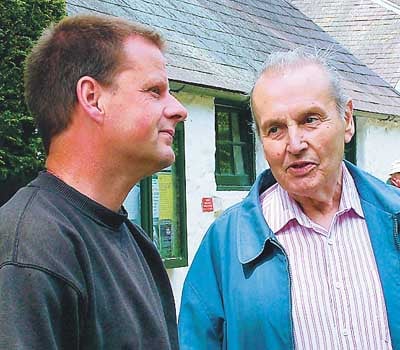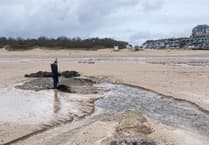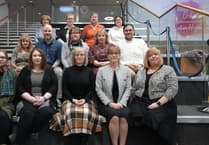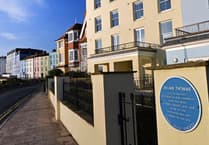When head gardener Steve Whitehead asked retired engineer Richard Powell to help him piece together the mining history of the Colby Estate, Richard thought it would be an interesting project and a six month job at most, but after one research visit to the National Library of Wales in Aberystwyth, he was completely hooked. Richard was amazed by the quantity of documents held at the library from letters patent and original maps, to newspaper reports and personal correspondence, all available for the meticulous task of plotting the social history of The National Trust's Colby Estate near Amroth. He quickly realised that there was a lot of local knowledge that had not been captured through the official records and invited the local community to share in the research with a special history day. John Colby had the Lodge built in 1803, a gentleman's residence from which he could hunt as well as keep an eye on his local mining interests. Apart from his brief military triumph in helping to repel the French Invasion of Fishguard in 1797, little is known about him. For Richard Powell, returning to primary sources at both the National Library and the Pembrokeshire Record Office have been key to finding out more about John Colby, the man and his mines. "Inspectors were appointed in 1840 to investigate the employment of women and children in the mines, and their reports make pretty sober reading, with stories of children as young as five employed underground, dragging carts of coal on all fours as the workings were under a metre high," said Richard. "What strikes me most is the huge gulf between the lives of the rich and the poor. During my research I came across the housekeeper's notes for the coming of age party in 1803 of Sir Hugh Owen, John Colby's ward, held at Orielton. The menu includes four haunches of venison, 12 roast geese, 18 ducks and 28 boiled fowls... to name but a few items. This was in stark contrast to the reports I found of labourers' dwellings in the 1840s which were no more than mud hovels." Steve Whitehead is keen for the Colby Story to be as complete as possible and is delighted with the support of the local community for the project. "The National Trust is committed to safeguarding cultural heritage, you just never know who is going to come forward with a missing piece of the jigsaw," he said. One such person is John Davies, of Whitland, whose grandfather, 'Jim Sparrow', worked on the estate for over 50 years. His real name was James Davies, but he got the nickname 'Sparrow' as he lived in a tied estate cottage called Sparrow's Nest. He began working at Colby in 1899, when Major Kay was the owner, and went on to be head gardener, retiring in 1950 aged 70! John vividly remembers his grandfather telling how on his first day one of the maids brought him out a jug of 'grey water' for his morning break, a mixture of water with a splash of milk! "Jim was a forceful character," commented John. "He said if he wasn't worth a cup of tea he'd go without. He always got his tea after that." John Davies also remembers Mrs. Crosland, Major Kay's daughter, from summer holidays spent with his grandfather in the 1940s. He can picture her still, working in the garden wearing a hessian sack apron and a broad brimmed hat. "She'd make a fuss of us children and give us strawberries when we visited," he recalled. Bill Burtenshaw-Haines was another head gardener who first worked at Colby in 1967 when the garden was owned by Peter Chance, former chairman of Christie's, who later bequeathed it to the National Trust. Bill worked almost exclusively in the walled garden which was then a working kitchen garden. Bill remembers bumper crops of peaches grown on the south facing wall and fruit cages with masses of red currants and strawberries. "The Chances came down to Colby most weekends," recalled Bill, "but if they weren't coming down I'd have to pack up boxes with fruit and veg and put them on the train up to London. They were always very fond of leeks." Another local lady, 93-year-old Dolly Lewis, of Wiseman's Bridge, has also contacted The National Trust with information about her late husband George Lewis, who worked at Colby as a young man in the 1920s. George Lewis later went on to work in the nearby colliery at Stepaside and Dolly actually went down the mine to see him at work, one Christmas Day in the mid 1930s. "They were not mining at the time, but they had to keep all the pumps going," said Dolly. "We walked underground as far as the old Wesleyan Chapel, but I did not want to go any further as I was scared of all the rushing water." Dolly still has a piece of the coal she hewed out herself, from the aptly named 'peacock' vein with its iridescent glow. Tony and Cynthia Scourfield-Lewis, of Colby Lodge, have enthusiastically joined in the project and have made available their personal collection of photographs and documents for the history day. Besides some stunning aerial photos of the house and garden, they have come up with the original sketch drawing for the West Wood summer house, built in the 1920s, and plans for the garden irrigation system created in the 1930s. Piecing together the Colby Story will take longer yet, as Steve and Richard realise that they have only just scratched the surface. Colby is all about its people, and like the coal seam which lies directly under the woodland garden, it may be small in area, but its stories are rich in quality. The Colby Story - a community day to discover the history of the people who lived and worked on the Colby Estate is planned for Sunday, June 15, from 10 am until 5p m. Further information from http://www.nationaltrust.org.uk/">www.nationaltrust.org.uk/ >http://www.nationaltrust.org.uk">www.nationaltrust.org.uk or call 01834 811885.

Head gardeners reminiscing, Steve Whitehead chats to Bill Burtenshaw-Haines.



